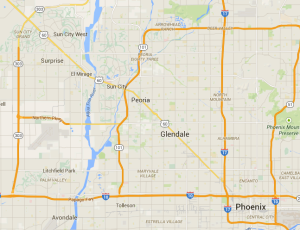Grand Avenue (U.S. 60 on the map) has challenges and potential so large it shouldn’t be ignored. It deserves more attention than it gets and probably more public resources than are available. A recent Republic article describes its current condition. An editorial I wrote in 2012 (below) has some of the hopeful attitude I still hold for it today.
Bringing Grand Ave. into the 21st century
(Arizona Republic editorial, April 1, 2012)
Grand Avenue has a history in the West Valley transportation system dating to 1888, when a road was built from Van Buren Street in downtown Phoenix to Glendale. In the 20th century, when it became a popular route to Los Angeles and Las Vegas, it earned its place in the national highway system.
But for all its history and its significance to the growth and development of West Valley communities, Grand Avenue now appears to be getting something it has needed for years: a fresh start, framed now by the parameters of a new charter and a regional-planning study.
The Maricopa Association of Governments’ executive committee last week selected a consultant to conduct the U.S. 60/Grand Avenue Corridor Optimization and Access Management Plan System Study, or COMPASS. The $850,000 MAG study of a stretch of Grand from Phoenix to Surprise will explore ways to improve traffic flow, provide details of adjacent property-access issues and develop a vision, goals and priorities for the thoroughfare, which today, on several levels — transportation, economic development, aesthetics — misses opportunities.
When completed in 18 months, the study should provide a plan for making Grand Avenue more of the 21st-century multimodal transportation solution and economic-development stimulator it should be. Our fear is that COMPASS will become another in a series of Grand Avenue studies that lands on a shelf collecting dust partly because of a lack of political will and cohesion.
Maybe that’s where the new Grand Avenue charter comes in.
The mayors of Phoenix, Glendale, Peoria, Youngtown, El Mirage and Surprise, as well as John Halikowski, director of the Arizona Department of Transportation, and Max Wilson, chairman of the Maricopa County Board of Supervisors, signed a charter last month that sets a tone for creating a shared vision for Grand Avenue. It also indirectly speaks to some of the recent political history of the corridor.
The charter, modeled after some language in Salt Lake City’s successful transportation-planning efforts, reads in part:
“We the partners commit, individually and as a team, to successfully study our project through open, honest, timely and active communication, mutual respect, trust and cooperation at all levels. We will plan our work proactively, coordinate with each other, and be flexible. As one team, we will remain focused to ensure that no issue becomes larger than our common goals.”
It seems odd — and yet oddly reassuring — to read a charter that establishes a code of conduct on the subject of Grand Avenue. As tensions rose from different ideas about the future of Grand, something needed to be done to get everyone on the same page. If that meant putting in writing the basic elements of professionalism and public service, so be it.
The charter and the study is a bookmark in the political saga of Grand Avenue. It’s important that we all know where we’ve been, see where we are and then turn the page.
